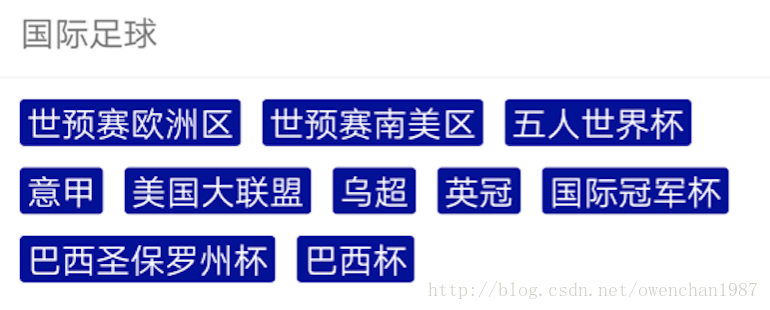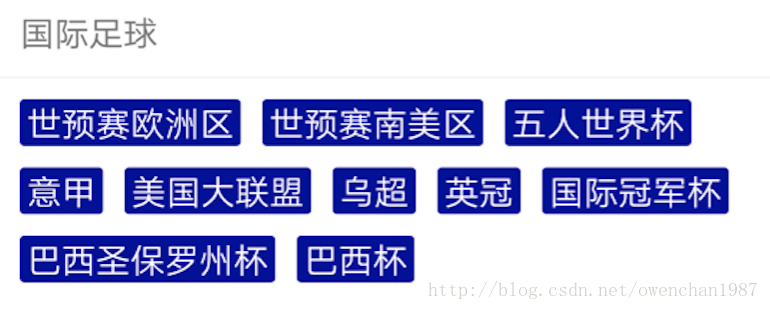溫馨提示×
您好,登錄后才能下訂單哦!
點擊 登錄注冊 即表示同意《億速云用戶服務條款》
您好,登錄后才能下訂單哦!
本文實例為大家分享了Android自定義控件ViewGroup實現標簽云的具體代碼,供大家參考,具體內容如下
實現的功能:

基本繪制流程:
構造函數獲取自定義屬性
onMeasure()方法,測量子控件的大小
onLayout()方法,對子控件進行布局
1、自定義屬性
<resources>
<declare-styleable name="TabsViewGroup">
<attr name="tabVerticalSpace" format="dimension" />
<attr name="tabHorizontalSpace" format="dimension" />
</declare-styleable>
</resources>
2、構造函數中獲取自定義屬性值
public TabsViewGroup(Context context, AttributeSet attrs) {
super(context, attrs);
TypedArray attrArray = context.obtainStyledAttributes(attrs, R.styleable.TabsViewGroup);
if (attrArray != null) {
childHorizontalSpace = attrArray.getDimensionPixelSize(R.styleable.TabsViewGroup_tabHorizontalSpace, 0);
childVerticalSpace = attrArray.getDimensionPixelSize(R.styleable.TabsViewGroup_tabHorizontalSpace, 0);
attrArray.recycle();
}
}
3、onMeasure函數測量子控件大小,然后設置當前控件大小
@Override
protected void onMeasure(int widthMeasureSpec, int heightMeasureSpec) {
int widthSize = MeasureSpec.getSize(widthMeasureSpec);
int heightSize = MeasureSpec.getSize(heightMeasureSpec);
int widthModel = MeasureSpec.getMode(widthMeasureSpec);
int heightModel = MeasureSpec.getMode(heightMeasureSpec);
//輸出寬度高度以及測量模式
Log.i(TAG, "sizeWidth :" + widthSize);
switch (widthModel) {
case MeasureSpec.AT_MOST:
Log.i(TAG, "Width model AT_MOST");
break;
case MeasureSpec.EXACTLY:
Log.i(TAG, "Width model EXACTLY");
break;
case MeasureSpec.UNSPECIFIED:
Log.i(TAG, "Width model UNSPECIFIED");
break;
}
Log.i(TAG, "sizeHeight :" + heightSize);
switch (heightModel) {
case MeasureSpec.AT_MOST:
Log.i(TAG, "Height model AT_MOST");
break;
case MeasureSpec.EXACTLY:
Log.i(TAG, "Height model EXACTLY");
break;
case MeasureSpec.UNSPECIFIED:
Log.i(TAG, "Height model UNSPECIFIED");
break;
}
//左右邊距
int left = getPaddingLeft();
int top = getPaddingTop();
//記錄每一行的寬度和高度
int lineWidth = 0;
int lineHeight = 0;
// 如果是warp_content情況下,記錄寬和高
int containerWidth = 0;
int containerHeight = 0;
// 遍歷每個子元素
for (int index = 0; index < getChildCount(); index++) {
View child = getChildAt(index);
if (child.getVisibility() == GONE) {
continue;
}
measureChild(child, widthMeasureSpec, heightMeasureSpec);
MarginLayoutParams params = (MarginLayoutParams) child.getLayoutParams();
int childWidth = child.getMeasuredWidth() + params.leftMargin + params.rightMargin + childHorizontalSpace;
int childHeight = child.getMeasuredHeight() + params.topMargin + params.bottomMargin + childVerticalSpace;
if (lineWidth + childWidth > widthSize - getPaddingRight() - getPaddingLeft()) {
containerWidth = Math.max(lineWidth, childWidth);
lineWidth = childWidth;
containerHeight += lineHeight;
lineHeight = childHeight;
Rect rect = new Rect(left,
containerHeight + top,
left + childWidth - childHorizontalSpace,
containerHeight + top + child.getMeasuredHeight());
child.setTag(rect);
} else {
Rect rect = new Rect(lineWidth + left,
containerHeight + top,
lineWidth + left + childWidth - childHorizontalSpace,
containerHeight + top + child.getMeasuredHeight());
child.setTag(rect);
lineWidth += childWidth;
lineHeight = Math.max(lineHeight, childHeight);
}
}
containerWidth = Math.max(containerWidth, lineWidth) + getPaddingLeft() + getPaddingRight();
containerHeight += lineHeight + getPaddingTop() + getPaddingBottom();
containerHeight -= childVerticalSpace;
setMeasuredDimension(widthModel == MeasureSpec.EXACTLY ? widthSize : containerWidth,
heightModel == MeasureSpec.EXACTLY ? heightSize : containerHeight);
}
4、onLayout函數對所有子控件重新布局
@Override
protected void onLayout(boolean changed, int l, int t, int r, int b) {
int childCount = getChildCount();
for (int i = 0; i < childCount; i++) {
View child = getChildAt(i);
if (child.getVisibility() == GONE) {
continue;
}
Rect location = (Rect) child.getTag();
child.layout(location.left, location.top, location.right, location.bottom);
}
}
使用方法
1、布局問自己中直接引用
<?xml version="1.0" encoding="utf-8"?>
<LinearLayout xmlns:android="http://schemas.android.com/apk/res/android"
xmlns:owen="http://schemas.android.com/apk/res-auto"
android:id="@+id/activity_main"
android:layout_width="match_parent"
android:layout_height="match_parent"
android:background="#ffffff"
android:orientation="vertical">
<TextView
android:layout_width="wrap_content"
android:layout_height="wrap_content"
android:padding="10dp"
android:textSize="16sp"
android:text="國際足球"/>
<View
android:layout_width="wrap_content"
android:layout_height="0.1dp"
android:background="#e0e0e0"/>
<com.ownchan.tabviewgroup.view.TabsViewGroup
android:id="@+id/tabs_view"
android:layout_width="match_parent"
android:layout_height="wrap_content"
android:padding="10dip"
owen:tabHorizontalSpace="10dp"
owen:tabVerticalSpace="10dp" />
</LinearLayout>
2、代碼添加標簽
@Override
protected void onCreate(Bundle savedInstanceState) {
super.onCreate(savedInstanceState);
setContentView(R.layout.activity_main);
initView();
}
private void initView() {
TabsViewGroup tabsViewGroup = (TabsViewGroup) findViewById(R.id.tabs_view);
LinearLayout.LayoutParams params = new LinearLayout.LayoutParams(ViewGroup.LayoutParams.WRAP_CONTENT,
ViewGroup.LayoutParams.WRAP_CONTENT);
String[] tabs = new String[]{"世預賽歐洲區",
"世預賽南美區", "五人世界杯", "意甲", "美國大聯盟", "烏超", "英冠", "國際冠軍杯", "巴西圣保羅州杯", "巴西杯"};
for (int i = 0; i < tabs.length; i++) {
TextView textView = new TextView(this);
textView.setText(tabs[i]);
textView.setTextColor(Color.WHITE);
textView.setBackgroundDrawable(getResources().getDrawable(R.drawable.tabs_bg));
textView.setGravity(Gravity.CENTER);
textView.setPadding(10, 0, 10, 0);
textView.setTextSize(16);
tabsViewGroup.addView(textView, params);
}
}
效果圖:

項目Github地址
以上就是本文的全部內容,希望對大家的學習有所幫助,也希望大家多多支持億速云。
免責聲明:本站發布的內容(圖片、視頻和文字)以原創、轉載和分享為主,文章觀點不代表本網站立場,如果涉及侵權請聯系站長郵箱:is@yisu.com進行舉報,并提供相關證據,一經查實,將立刻刪除涉嫌侵權內容。